Arizona Employees: Beware of Red Flags in Severance Agreements and How to Protect Yourself
The termination of employment can be a difficult experience, particularly when presented with a severance agreement intended to facilitate the transition. While these documents might seem like a generous parting gift, they often include language and clauses that can affect your rights and future opportunities. We help employees in Arizona know exactly what you’re agreeing to before putting pen to paper.
This article will walk you through everything you need to understand: the essential elements of a severance agreement, the red flags that signal a need for legal advice, and what to do when you receive this document.
Keep reading to know how Frankel Syverson PLLC can help you with any doubts you might have regarding this critical document.
What is a Severance Agreement?
A severance agreement is a contract between an employer and an employee, usually offered when the employment relationship ends. In it, the employer outlines the terms of the separation, including any compensation, benefits continuation, and release of claims.
Think of it as a mutual understanding: in exchange for certain benefits (like a severance payment), the employee agrees to release the employer from potential legal claims.
It's often used to provide a smooth transition for both parties, but it's crucial to remember that it’s a legal document with binding terms. While these agreements are common, they are often negotiable and should be reviewed carefully.
In the sections below, we’ll break down the key components you’ll find in severance agreements that Arizona employees should be mindful of.
The 8 Most Critical Components of Severance Agreements
1. Severance Payment Structure
This is often the first thing people look for. It details the amount of money you’ll receive, how it will be paid (lump sum, installments), and the timeline for those payments.
It’s important to understand if the amount you’re being offered is fair under the circumstances and if the payment is contingent on any future actions from your side.
2. Release of Claims Provision
This is one of the most significant parts of a severance agreement.
By signing, you typically agree to waive your right to sue the employer for almost any claim related to your employment or its termination. This can include claims for discrimination, wrongful termination, wage disputes, and more.
3. Post-Employment Restrictions
Many agreements include clauses that limit your actions after you leave the company. These can include:
Non-Compete Clauses: Restricting your ability to work for a competitor within a certain geographic area or for a specific period.
Non-Solicitation Clauses: These are designed to protect the former employer's business interests by restricting a departing employee's ability to recruit former colleagues or solicit the company's existing clients for a specified period after their employment ends.
Non-Disclosure Agreements (NDAs): Protecting company secrets and proprietary information.
It’s important to assess if these restrictions are reasonable and won't hinder your future career moves.
4. Confidentiality and Non-Disparagement
These clauses often go hand-in-hand. Confidentiality ensures you won't reveal sensitive company information. Non-disparagement means you agree not to make negative statements about the company, its employees, or its products/services. Sometimes, a non-disparagement clause is mutual, meaning the employer also agrees not to disparage you.
Check that these clauses are balanced and don’t limit your free speech.
5. Return of Company Property
This section outlines your obligation to return all company-owned property, such as laptops, phones, access cards, and documents. It often specifies deadlines and conditions for this return.
Failure to comply could put your severance at risk.
6. Continued Benefits
Severance agreements frequently address the continuation or cessation of your employee benefits, such as health insurance (COBRA options), life insurance, and retirement plans.
You need to be completely aware of how long these benefits will last and what your options are for continuing coverage.
7. References and Employment Verification
This clause dictates how the company will respond to future employment verification requests or reference checks. Ideally, it should specify a neutral reference or a statement agreed upon by both parties to protect your professional reputation.
It’s important to confirm that the language aligns with your expectations.
8. OWBPA Requirements for Employees 40+
If you are 40 years of age or older, federal law (the Older Workers Benefit Protection Act, or OWBPA) provides additional protections regarding the waiver of age discrimination claims.
This section will typically outline specific requirements, such as a minimum review period (21 or 45 days) and a revocation period (7 days) after signing.
Make sure this federal protection is honored.
Step 1: Try Not to Rush if Possible
This is the most critical piece of advice. Employers often impose deadlines, but these are almost always negotiable. Take a deep breath. You want to review the document thoroughly and, more importantly, to seek legal counsel. Rushing into a signature can have long-term consequences.
Step 2: Identify What You’re Being Offered
Carefully read through the agreement to understand the full scope of what your employer is proposing. This includes the financial compensation, the continuation of benefits, the return of property, and any additional perks and promises about references.
Make a list of everything on the table.
Step 3: Understand What You’re Giving Up
It is essential to understand what you’re waiving. The “Release of Claims” section will be essential here.
Are you giving up the right to pursue potential legal actions you might have? Are there any claims you’re unsure about? This is where legal review like the one we offer becomes essential.
Step 4: Recognize If You Have Leverage
You might have more leverage than you think. Consider factors like:
Reasons for termination: Was it a layoff, a performance issue, or something else? If there’s any potentially unlawful conduct by the employer, your leverage increases.
Company's desire for a release: Is the company trying to avoid potential litigation?
Your value to the company: Were you a long-term, high-performing employee? Understanding your position can help you in negotiations.
Step 5: Decide Your Next Move
Once you've reviewed the agreement and considered your options, you'll need to decide whether to:
Sign the agreement as is.
Negotiate some or all of the terms.
Refuse to sign and explore other avenues (like pursuing legal claims if applicable).
This decision should be made with a clear understanding of the implications of each choice.
Step-by-Step:
What to Do When You Receive a Severance Agreement
9 Red Flags That Require Legal Review Before Signing
1. Potential Legal Claims You're Waiving
If you believe you might have been subjected to discrimination, harassment, retaliation, or any other unlawful employment practice, signing a severance agreement could mean giving up significant legal rights and potential compensation. It is also important to know the strengths and weaknesses of any potential legal claims to consider whether the severance offer is fair.
2. Severance Amount Below Industry Standards
Is the proposed severance pay significantly less than what's typically offered in your industry for someone with your tenure and position? We can help you determine if the offer is fair.
3. Overly Restrictive Non-Compete Terms
A non-compete clause that’s too broad in scope, duration, or geographic area can severely limit your ability to find new employment.
Arizona law outlines fundamental requirements for non-compete clauses to be valid. However, Arizona courts assess the enforceability of these clauses individually, considering all specific details of each case. We can help you evaluate the language that is proposed for you.
4. Missing or Inadequate Consideration
For an agreement to be legally binding, there must be "consideration", meaning something of value exchanged by both parties. In the context of a severance agreement, this typically refers to the benefits your employer is offering you in exchange for your agreement to release potential legal claims.
If you're asked to sign a severance agreement after you've already been working for the company, the consideration usually needs to be something new of value that you weren't already entitled to. This most commonly includes the severance payment itself, extended benefits beyond what's legally required, or perhaps a positive reference.
If the offer seems negligible or disproportionately small for the significant rights you're giving up (like waiving legal claims), or if you weren't offered anything new of value when signing, it might indicate insufficient consideration. This is a critical point that employees should consider reviewing with a lawyer.
5. Accelerated or Pressured Timeline
If your employer is pressuring you to sign immediately or giving you an unreasonably short deadline, it's a major warning sign. This is especially true if you are over 40 and are not given the OWBPA-mandated 21 or 45 days to review.
6. One-Sided Non-Disparagement
While mutual non-disparagement is common, an agreement that only prevents you from speaking negatively about the company, but doesn't restrict them from disparaging you, is a red flag.
7. Confidentiality Overreach
A confidentiality clause that attempts to restrict you from discussing publicly available information or your own employment terms (like salary) may be overly broad and problematic.
8. Inaccurate Employment Details
Check for any inaccuracies regarding your job title, dates of employment, salary, or reason for termination. Errors here could impact future employment verification or benefit eligibility.
9. Ambiguous or Unclear Language
If any part of the agreement is difficult to understand, vague, or open to multiple interpretations, it could lead to future disputes. A good agreement should be clear and concise. A lawyer can help you navigate changes in the language that benefit you.
We can help you determine if your severance agreement is fair.
How Frankel Syverson PLLC Helps Arizona Employees with Severance Agreements
At Frankel Syverson PLLC, we understand that receiving a severance agreement can be a stressful and confusing time. We are dedicated to helping Arizona employees navigate these complex documents with confidence.
Our experienced employment law attorneys provide comprehensive legal review, ensuring you fully understand every clause and its implications. We help you identify red flags, assess your leverage, and strategically negotiate for more favorable terms, including increased severance pay, improved benefits, and reasonable post-employment restrictions,
We partner with you from day one. Our services include:
Detailed review of your severance agreement to identify hidden pitfalls.
Strategic negotiation to improve the financial and non-financial terms.
Experienced guidance on federal and Arizona-specific laws, including OWBPA.
Support with post-employment restrictions and benefits continuation.
Our goal is to empower you to make the best decision for your future and ensure your rights are protected.
A severance agreement is a legally binding contract that can significantly shape your post-employment life. By understanding its key components, taking deliberate steps when you receive one, and recognizing critical red flags, you can protect your interests.
Remember, you don't have to navigate this alone. Seeking timely legal advice from experienced employment attorneys like the ones at Frankel Syverson PLLC is the smartest investment you can make to ensure a fair and favorable outcome.
Ready to review your severance agreement? Fill out our contact form to see if we can help.
FAQ
-
No. Employers in Arizona are not legally required to offer severance agreements unless there is a pre-existing contract (like an employment agreement or collective bargaining agreement) that mandates it. Offering one is typically a choice made by the employer to secure a release of claims.
-
There's no single standard formula. Severance pay often depends on factors like your length of service, your position, industry standards, the company's financial health, and the reason for termination. A common guideline is one to two weeks of pay per year of service, but this can vary widely.
-
A "standard" package often includes a severance payment, continued health benefits for a period (or COBRA subsidy), and an agreement on how employment verification will be handled. However, what constitutes "standard" is highly dependent on the specific circumstances of your employment and the company.
-
The time limit is usually set by the employer. If you are under 40, there is no minimum time frame, but it's advisable to take at least a few days if you can. If you are 40 or older, federal law (OWBPA) requires employers to give you at least 21 days to review the agreement if you are an individual employee, or 45 days if part of a group termination. Employees over 40 also have 7 days to revoke the agreement after signing.
-
If you refuse to sign, you typically will not receive the severance benefits offered. This doesn't necessarily mean you can't pursue other avenues, such as filing for unemployment or, if you believe you have valid legal claims, pursuing a lawsuit against your former employer.
-
Absolutely! Most severance agreements are negotiable. This is where legal counsel becomes invaluable. An attorney can help you identify areas for negotiation and advocate on your behalf for better terms, such as increased pay, extended benefits, or less restrictive post-employment clauses.
-
Generally, no. The primary purpose of a severance agreement for the employer is to obtain a “release of claims,” meaning you waive your right to sue them for most employment-related issues. However, there are very limited circumstances where a waiver might be challenged (e.g., if it was signed under duress or doesn't meet specific legal requirements). Sometimes a more limited release could be considered in the negotiation as well.
-
No, signing a severance agreement does not mean your employer admits to any wrongdoing. Severance agreements almost always include language stating that signing is not an admission of liability or fault by the employer. They are often offered for business reasons, such as avoiding potential litigation.
-
Once both parties have signed a severance agreement, it becomes a legally binding contract and generally cannot be unilaterally revoked by the employer, unless a specific revocation clause is included (which is rare for employer-initiated revocations). However, if you are over 40, you typically have a 7-day period to revoke your signature after signing.
-
A valid severance agreement cannot waive certain rights, such as the right to file a charge with the Equal Employment Opportunity Commission(EEOC) or participate in an EEOC investigation. It also should not release claims that arise after the agreement is signed.




